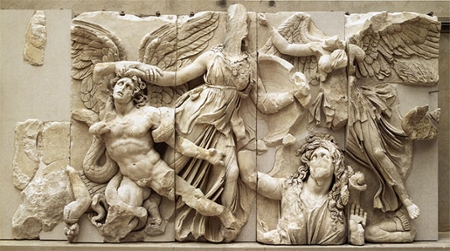Paper Topics | Spring 2014 | Paper 2
Due Saturday, March 7th, 5 p.m., in your conference leader's Eliot Hall mailbox.
Maximum length: 1,500 words
Choose one of the following questions:
-
In Book 2 (1107a) of the Nicomachean Ethics, Aristotle defines moral virtue as follows:
Virtue, then, is a state that decides, consisting in the mean, the mean relative to us, which is defined by reference to reason, that is to say, to the reason by reference to which the prudent person would define it. It is a mean between two vices, one of excess, and one of deficiency.
Using Aristotle's account of the moral virtue of courage in Book 3, sections 6-9 (1115a8-1117a29), discuss how well each part of his account of courage corresponds to his general definition of moral virtue from Book 2. Is Aristotle's account of the moral virtue of courage consistent and/or convincing? Are there problems with his account?
-
No one, it appears, has friends in the Kallipolis: or at least, Plato did not see fit to talk about friendship in the Republic. Aristotle, however, devotes two books of his Nicomachean Ethics to the subject. Why is friendship so important to Aristotle's understanding of politics? How does the attention to friendship in the Ethics and the absence of it in the Republic reflect fundamental differences in Aristotle's and Plato's views of politics?
-
Like the book of Revelation and Ezekiel, Daniel is an important work of apocalyptic literature. In everyday speech apocalypse means "end of the world," but the original Greek means "revelation" or "lifting of the veil." Lifting the veil can refer either to the way in which the boundary between the sacred and profane, the heavens and earth, or the concealed and revealed disappears. Using two or three key passages explain what the author of Daniel argues will happen when the veil is lifted. How will the sacred, heavenly, or concealed become known? How the style of the book reinforce the violation of these boundaries?
-
Athena was both the patron goddess of Athens and of Pergamon. Perhaps not coincidentally, Pergamon saw itself as a new Athens. Doing a close reading of the portion of the Pergamon Altar in which Athena and Nike fight Alkyoneus (below and http://cdm.reed.edu/u?/vrcwork,97408), examine how the Altar reworks the sculptural tradition of the Athenian Acropolis, by comparing the Pergamon scene either to (1) to earlier classical depictions of Athena found on the Acropolis, such as the relief sculpture of Nike (victory) adjusting her sandal (http://cdm.reed.edu/u?/vrcwork,2455) OR (2) to scenes of battle in the Parthenon metopes such as the battle between the lapiths and centaurs (http://cdm.reed.edu/u?/vrcwork,115882). Make sure you discuss both the style of the works and the major themes of each scene. How does the Pergamon Altar use formal features to both connect itself to and distinguish itself from earlier visions of Athens?

-
Theocritus's "Idyll 11: The Cyclops' Serenade" reworks the rather negative portrait of Polyphemos from book nine of the Odyssey by making the Cyclops into a figure of pathos and longing. Do a close reading of Idyll 11 in which you pay attention to how Theocritus uses rhetorical and poetics features to build our sympathy for the Cyclops. (Note: You do not have to have read the Odyssey to answer this question.)
-
Both the books of Exodus and Esther concern the deliverance of the Israelite/Jewish people from oppression: slavery in Egypt in the case of Exodus and Haman's genocidal plan in Esther. In what ways does the Esther narrative diverge from the Exodus narrative, and in what ways does it conform to it? How does Esther's mode of defending and protecting her people compare to that of Moses? In comparing the two narratives, you might consider the representation of political authority (Pharaoh, Ahasuerus), the means by which deliverance is achieved, or the nature of the victory enjoyed by the underdog in either case.
-
Compare the constitution of Rome, as described by Polybius, with the constitution of the Kallipolis, as described in Plato's Republic. To what extent did Polybius and Plato have a common sense of what makes a city work well?
-
Write your own essay topic. If you choose this option, it is necessary to have your conference leader approve your topic before you start working on it.